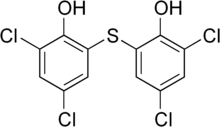Bithionol
 | |
 | |
| Clinical data | |
|---|---|
| Other names | 2,4-dichloro- 6-(3,5-dichloro- 2-hydroxyphenyl)sulfanylphenol |
| ATC code | |
| Identifiers | |
| |
| CAS Number | |
| PubChem CID | |
| IUPHAR/BPS | |
| DrugBank | |
| ChemSpider | |
| UNII | |
| ChEBI | |
| ChEMBL | |
| CompTox Dashboard (EPA) | |
| ECHA InfoCard | 100.002.333 |
| Chemical and physical data | |
| Formula | C12H6Cl4O2S |
| Molar mass | 356.05 g/mol g·mol−1 |
| 3D model (JSmol) | |
| |
| |
| | |
Bithionol is an anthelmintic used to treat Anoplocephala perfoliata (tapeworms) in horses[1] and Fasciola hepatica (liver flukes).
References
- ^ Sanada Y, Senba H, Mochizuki R, Arakaki H, Gotoh T, Fukumoto S, Nagahata H (2009). "Evaluation of Marked Rise in Fecal Egg Output after Bithionol Administration to Horse and its Application as a Diagnostic Marker for Equine Anoplocephala perfoliata Infection" (pdf). Journal of Veterinary Medical Science. 71 (5): 617–620. doi:10.1292/jvms.71.617. PMID 19498288.
